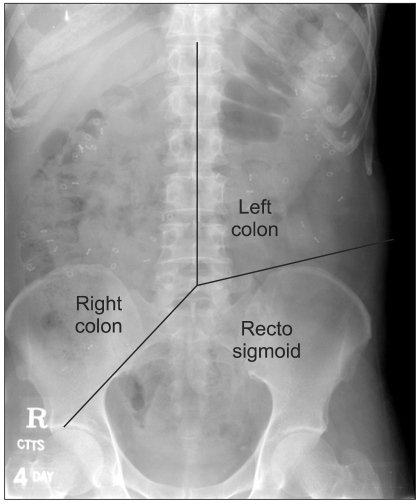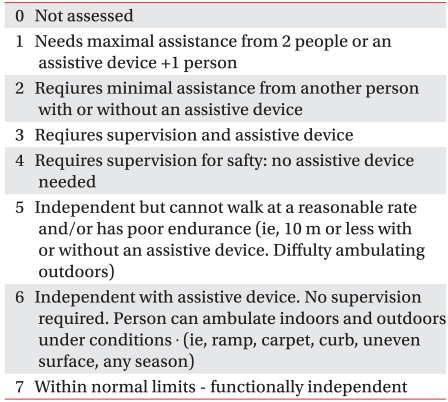1. Scivoletto G, Fuoco U, Badiali D, Braccl F, Lucente LD, Patrelli A, Vona VU, Tnillo D, Castellano V, Corazzian E. Gastrointestinal dysfunction following stroke. J Neurol Sci 1997;150:S151.

2. Robain G, Chennevelle JM, Petit F, Piera JB. Incidence of constipation after recent vascular hemiplegia: a prospective cohort of 152 patients. Rev Neurol 2002;158:589-592. PMID:
12072827.

3. Harari D, Norton C, Lockwood L, Swift C. Treatment of constipation and fecal incontinence in stroke patients: randomized controlled trial. Stroke 2004;35:2549-2555. PMID:
15486330.


4. Krogh K, Christensen P, Laurberg S. Colorectal symptoms in patients with neurological disease. Acta Neurol Scand 2001;103:335-343. PMID:
11421845.


5. Roth EJ. Medical complication encountered in stroke rehabilitation. Phy Med Rehabil Clin North Am 1991;2:563-578.

6. Wrenn K. Fecal impaction. N Engl J Med 1989;321:658-662. PMID:
2671728.


7. Bracci F, Badiali D, Pezzotti P, Scivoletto G, Fuoco U, Di Lucente L, Petrelli A, Corazziari E. Chronic constipation in hemiplegic patients. World J Gastroenterol 2007;13:3967-3972. PMID:
17663511.



8. Garrigues V, Bau I, Bastida G, Galvez C, Ponce J. Concordance between rome and rome II criteria for chronic constipation, a population-based study. Gastroenterology 2001;120:A634.

9. Demeurisse G, Demol O, Robaye E. Motor evaluation in vascular hemiplegia. Eur Neurol 1980;19:382-389. PMID:
7439211.


10. Korner-Bitensky N, Mayo N, Cabot R, Becker R, Cooperismith H. Motor and functional recovery after stroke: accuracy of physical therapists' predictions. Arch Phys Med Rehabil 1989;70:95-99. PMID:
2644920.

11. Su Y, Zhang X, Zeng J, Pei Z, Cheung RT, Zhou QP, Ling L, Tan J, Zhang Z. New-onset constipation at acute stage after first stroke incidence, risk factors, and impact on the stroke outcome. Stroke 2009;40:1304-1309. PMID:
19228840.


12. Metcalf AM, Phillips SF, Zinsmeister AR, MacCarty RL, Beart RW, Wolff BG. Simplified assessment of segmental colonic transit. Gastroenterology 1987;92:40-47. PMID:
3023168.


13. De Looze DA, De Muynck MC, Van Laere M, De Vos MM, Elewaut AG. Pelvic floor function in patients with clinically complete spinal cord injury and its relation to constipation. Dis Colon Rectum 1998;41:778-786. PMID:
9645749.


14. Choi H. Measurement of Colon transit time. Korean J Gastrointest Motil 1999;5:198-206.
15. Belsey J, Greenfield S, Candy D, Geraint M. Systemic review: impact of constipation on quality of life in adults and children. Aliment Pharmacol Ther 2010;31:938-949. PMID:
20180788.


16. Lehmann JF, DeLateur BJ, Fowler RS Jr, Warren CG, Arnhold R, Schertzer G, Hurka R, Whitemor JJ, Masock AJ, Chambers KH. Stroke rehabilitation: outcome and prediction. Arch Phys Med Rehabil 1975;56:383-389. PMID:
809023.

17. Jongbloed L. Prediction of function after stroke: a critical review. Stroke 1986;17:765-776. PMID:
3526649.


18. Skilbeck CE, Wade DT, Hewer RL, Wood VA. Recovery after stroke. J Neurol Neurosurg Psychiatry 1983;46:5-8. PMID:
6842200.



19. Rao SS, Sadeghi P, Beaty J, Kavlock R, Ackerson K. Ambulatory 24-h colonic manometry in healty humans. Am J Physiol Gastrointest Liver Physiol 2001;280:G629-G639. PMID:
11254489.


20. Min KC, Chong SY, Chung JS. A survey of defecation pattern after discharge in stroke patients. J Korean Acad Rehabil Med 2000;24:388-394.
21. Nino-Murcia M, Stone JM, Chang PJ, Perkash I. Colon transit in spinal cord-injury patients. Invest Radiol 1990;25:109-112. PMID:
2312245.


22. Lim SS, Choi KH, Myung SJ, Sung IY. Evaluation of the neurogenic bowel by colon transit time and anorectal manometry in the spinal cord injured patients. J Korean Acad Rehabil Med 2001;25:249-255.
23. Del Giudice E, Staiano A, Capano G, Romano A, Florimonte L, Miele E, Ciarla C, Campanozzi A, Crisanti AF. Gastrointestinaal manifestations in children with cerebral palsy. Brain Dev 1999;21:307-311. PMID:
10413017.


24. Park ES, Park CI, Cho SR, Na SI, Cho YS. Colonic transit time and constipation in children with spastic cerebral plasy. Arch Phys Med Rehabil 2004;85:453-456. PMID:
15031832.













